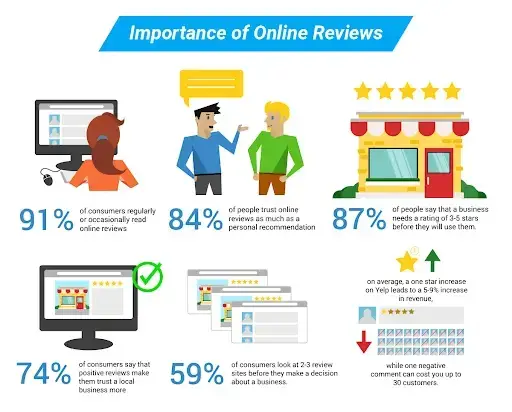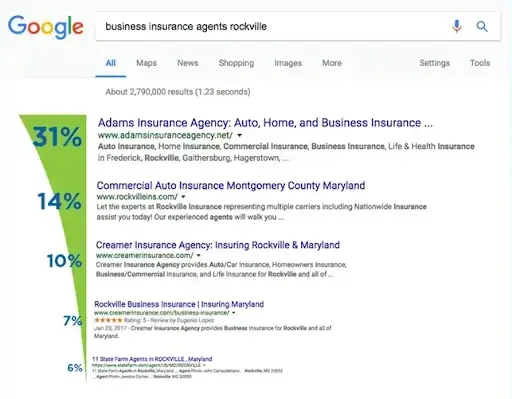We all know that cliché “you shouldn’t care about what others think”.
Well, it shouldn’t be surprising to learn that things don’t work that way in the business world.
Research has shown that 85% of people conduct online research to see what others say about brands before making a purchase.
And if your online reviews are dismal, it might prevent new customers from making a purchase from you in their lifetime.
Keeping customers happy is one of every business’s most challenging tasks.
And the fact that it’s a continuous process doesn’t make it any easier.
Yet, despite all your efforts, a single bad review from a disgruntled customer might endanger everything you’ve been building for years.
That’s why taking care of your reputation is just as important as the price and quality of service delivery.
And that’s where online reputation management strategies come into play.
Here are nine ways how to manage your online business reputation as efficiently and effectively as Fortune 500 companies.
1. Find out what others are saying about you
Before you start managing your online reputation, you must first gauge what people are saying about you.
One way to do this is to check your existing online reviews. It might be intimidating to read hundreds of reviews about something you hold close to your heart might be intimidating.
Where to look for reviews might depend on your industry and niche, but the obvious first choice is Google, as research has found that 63% of consumers will check your reviews on Google before they visit your website.
Next on the list is Yelp, where 45% of consumers come to research a brand before making a purchase.
TripAdvisor comes third on the list, with 30% of people that use it to research a brand.
And last on this list is Facebook, attracting 24% of consumers who might research you there.
2. Assess the issue
In a world where millions of people can access your brand, avoiding negative comments is nearly impossible.
When it happens, the last thing you should do is become emotional and take a defensive stance. Or, even worse – ignore it.
Every negative comment is a small fire that can spread and cause severe damage to your brand’s reputation.
And if you handle the review response poorly, it might signal to other potential customers that the negative review was right.
Instead, try to embrace the attitude that every negative feedback is an opportunity to improve.
Approach every dissatisfied customer with care and empathy and respond to their complaint as quickly as possible.
Even if the problem is unsolvable, it will show other prospective customers that your brand is honest and transparent and that you genuinely care about their experience.
3. Have a strategic approach to online reviews
For the reasons listed above, you need to prepare a system for responding to positive and negative reviews.
And it should apply to every platform where your brand has a presence.
It doesn’t take much brainpower to devise a way to respond to positive reviews. Simply express gratitude for the customer’s feedback and reiterate their praised qualities.
Here’s a good example:
Things get tricky when it comes to negative feedback. As a rule of thumb, you should at least acknowledge the customer’s problem, apologise, and avoid taking to a defensive tone at all costs.
One good way to calm the tension is to suggest that the customer contact your support team and move the conversation offline if possible.
And do it quickly, as 53.3% of reviewers demand a response within seven days.
Here’s what an excellent response to a negative could look like:
4. Incentivise your customers to leave a review
You can see how powerful online reviews are and how they can make or break your business.
That’s why, if your existing customers are happy with you, there is no reason not to ask them to share their experiences with others.
Research has shown that 70% of people are willing to leave positive feedback if asked.
There are numerous ways to incentivise your customers to leave a review, especially if they are satisfied with your product or service. To name a few:
Offer a small discount in exchange for feedback on Google or Yelp
Add a pop-up window on your website after they make a purchase
Send a request via email and ask the customer to share their experience
Of course, be careful not to bribe your customers for ‘positive’ reviews. Some countries have laws that stipulate that you cannot request misleading or false reviews.
There’s an interesting article that explores these laws in Australia on how to manage your business’s online reputation in regard to false reviews.

5. Monitor your mentions
Too often, you’ll discover a devastating review. Shortly after, you’ll find that there has been a loss in revenue.
By this point, your online reputation is already (hopefully temporarily) damaged.
But you don’t have to wait to accidentally find this out by stumbling upon a negative review; some tools can help you monitor your online mentions and react as soon as they appear.
One of the most popular tools is Google Alerts. But BuzzSumo, My Tweet Alerts and Brand Mention are no less powerful.
Each of these tools will search the internet for you and notify you whenever someone mentions your brand’s name.
You can set up keywords for them to look for, and they will highlight any new comment or review that mentions your business.
6. Make sure you appear on the first page of the search results
We already mentioned the power Google and similar reputation websites have over your brand.
People will search for your name or related product terms, and what appears in their search will likely determine whether or not they will become your customers.
That’s why having a spot on the first page of the Google search is imperative. If your brand doesn’t show up for your search terms, it in and of itself is damaging to the brand.
That’s why you should establish an SEO strategy that includes local SEO to ensure you rank for all the branded terms connected to your business.
This takes time and deliberate strategy. But a surefire way to be seen for your brand is to create a Google My Business account and optimise the listing with keyword-rich descriptions, FAQs, images, and products/services.
Take a proactive approach to your online reputation and be in control of what appears when others search your name.

7. Create content of value
You must continually create fresh, helpful, and up-to-date content to stay on top of search results.
It shouldn’t surprise you that 75% of customers say that the quality of any brand’s digital content was the determining factor in their decision to make a purchase.
Use that stat to your advantage.
By creating content that is relevant and up-to-date, you’re placing yourself in a position of authority. Here, you can have better control and influence over your customers’ purchasing process.
Without high-quality content, you’re risking becoming irrelevant and outdated, which will ultimately be reflected in your revenue stream (and SEO rankings. See Google’s Helpful Content update).
If you cannot provide accurate answers to questions your prospective customers have, they will simply bounce and find another provider who can.
Also, you should know that there are no rules when it comes to the type of content you should be creating.
Some industries value podcasts and webinars, some will prefer blog posts, articles, news, and case studies.
Always test what type of content produces the best results and adapt your strategy to the data that you find.
8. Last resort: legal steps you can make
Although trying to remove inaccurate bad reviews from your profile may seem impossible, sometimes legal action is the only thing left to do.
As you grow more successful, there will be cases where others will try to undermine your success.
You might encounter websites that are trying to defame you, spread fake news about your brand, and abuse its name.
You might also encounter trademark or copyright violations with counterfeit products or targeting by competitors.
Taking down a web page that threatens your business is in no way a straightforward process, especially if it isn’t immediately evident that the webpage is engaging in false and defamatory claims.
However, several determining factors can decide if the website is in violation of your rights. The most important are:
- Violation of your country’s laws and regulations
- Breaking the ISP terms of use
- Violating the hosting site’s terms of use
- Not following the search engine’s quality guidelines
Also, be attentive to the content creator’s intent and motivation.
If you find that they have personal reasons for engaging in a campaign against you, that might be grounds for legally compelling them to remove the content they created and shut down the malicious website.
9. Embrace the negativity and work through it
After years of building your online reputation, you’ll quickly learn that it’s virtually uncontrollable to some extent.
Because of that, managing your online reputation will often be accompanied by anxiety and discomfort. Sometimes the only thing you can do is not to allow yourself to succumb to them (which will happen in the SaaS and eCommerce space).
Negative comments will sometimes pop up from nowhere, your position on search engines might vary from week to week, and crises might emerge when you least expect them.
Just because you find yourself tangled in events that are out of your control does not mean you should lose control over how you handle the situation.
Keep a cool head, face the issue with politeness, empathy, and honesty, and follow the advice you’ve read here today to learn that the storm ends the same way it began. Stay frosty.

